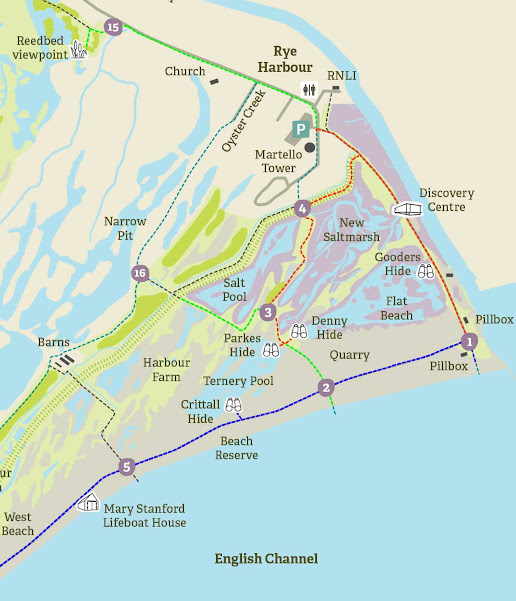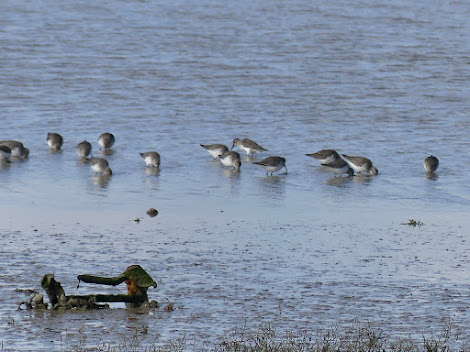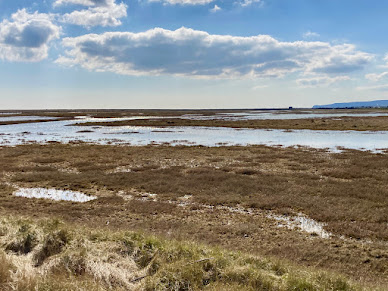Sunday 16th March
2025
Rye
Harbour NNR, East Sussex
Ashdown
Bird Group
(11
members present)
Trip Report
This was
another excellent turnout from our members, befitting the fine weather and picturesque setting. The clear sky and the gentle, if
somewhat cold, breeze contrived to show the reserve at its very best.
With over
sixty species recorded today, Mother Nature also showed her appreciation.
Our target species were the Sandwich Terns
returning from Africa and a Spotted Redshank that had been around for some
time.
John and
Joy have close connections with Rye Harbour NNR, so we took their advice and
navigated around the reserve in a slightly different way than
normal. We followed the anticlockwise route (markers 4 to 3 to 2 to
1 to P, on the map below) to maximise our chances of seeing the Spotted
Redshank, which was most likely to be found on the Salt Pool. Before
that, however, we visited Gooders Hide – to leave it until later in the day
would have meant looking directly into bright sunshine.
It didn’t
take long to find our first target species.
- We
saw a flock of Sandwich Terns flying
over us at Gooders Hide, looking majestic in the favourable light.
Courtesy of Phil Aylen
- Martin
managed to photograph one of them on
an island with the Oystercatchers.

Courtesy of Martin
Jeffree
Most of us
were keen to seek our second target species.
Once again, it didn’t take long as the Spotted Redshank was on the Salt Pool just as Joy and John had
predicted.
- The
bird was on one of the islands along with several Wigeon. It had its beak
tucked in and remained stubbornly stationary throughout our initial
observation.
Courtesy of Ian Hodgson
- Some of us moved on, confident in our ID. Thankfully most of our photographers stayed
put and they were rewarded with some terrific views when the Spotted Redshank
awoke and started to move around.
Courtesy of Andrew Burns
Courtesy of Ian Hodgson
The
following two photographs show some of the differences between the Spotted
Redshank and the more common Redshank - namely the brighter colouration, the prominent
white fore-supercilium and the longer, narrower beak which has a distinctive
but very subtle downward droop near the tip.
Courtesy of Phil Aylen
Courtesy of Phil Aylen
We were barely a quarter of the way around the reserve
and already we had seen both target species.
There were
many other highlights at various places on the reserve.
- Avocets are always popular here and today
they looked particularly splendid in the bright sunshine.
Courtesy of Martin
Jeffrree
Courtesy of Andrew Burns
- Dunlin graced the muddy areas in front of
Gooders Hide.
Courtesy of Ian Hodgson
Little Egrets flourish here too!
Courtesy of Martin
Jeffree
- Wow! This humble Herring Gull looking absolutely fabulous.
Courtesy of Phil Aylen
So
too this cracking Wigeon.
Courtesy of Andrew Burns
Not
forgetting the Little Grebes.
Courtesy of Andrew Burns
Passerines
were few and far between. We made a
detour from the Salt Pool towards the Narrow Pit (connecting markers 3 and 16
on the map) to check out the bushes for passerines and, in particular,
Wheatears.
- ·
Alas
we were unsuccessful with the latter - in fact we didn’t see any Wheatears at
all today.
- · There
were good numbers of Reed Bunting, Skylark, Goldfinch, Meadow Pipit
and Stonechat.
By late
morning, we were feeling the chill of the wind so we took refuge in Denny Hide.
·
Here,
Mark heard, and then saw, a Grey
Partridge.
We made a
brief sea-watch (marker 2 on the map).
·
It
was high tide and with no sandy patches exposed, no Sanderlings were seen.
·
We
had no luck too when we used our telescopes to overlook Camber Sands from the Pillbox
area (marker 1 on the map). The high
tide meant that the narrow band of sandy beach was overcrowded with dog walkers
and day-trippers.
We only saw
three raptor species today-
- ·
This
superb Kestrel was patrolling the
main reserve.
Courtesy of Andrew Burns
- ·
This
Marsh Harrier showed up at the
Reedbed viewpoint (marker 15 on the map) which we visited after lunch.
As well as
the Marsh Harrier, the afternoon session at the Reedbed viewpoint produced
further highlights-
- ·
A
single bearded tit, skulking at
water level in the reeds, provided us with perhaps our biggest challenge of the
day. Some of us missed it!
- · Our
first Kingfisher of the day was very
well received.
- ·
We
were unsure about an earlier sighting of a Mediterranean
Gull so we were delighted to confirm one here.
- ·
Two
Snipe took to the air in front of
us, probably spooked by the Marsh Harrier.
Species List:
|
Name:
|
Count:
|
|
Name:
|
Count:
|
|
Avocet
|
1
|
|
Little Grebe
|
32
|
|
Bearded Tit
|
2
|
|
Long-tailed Tit
|
33
|
|
Black-headed Gull
|
3
|
|
Magpie
|
34
|
|
Blackbird
|
4
|
|
Mallard
|
35
|
|
Blue Tit
|
5
|
|
Marsh Harrier
|
36
|
|
Brent Goose
|
6
|
|
Meadow Pipit
|
37
|
|
Buzzard
|
7
|
|
Mediterranean Gull
|
38
|
|
Canada Goose
|
8
|
|
Oystercatcher
|
39
|
|
Carrion Crow
|
9
|
|
Pied Wagtail
|
40
|
|
Collared Dove
|
10
|
|
Pintail
|
41
|
|
Coot
|
11
|
|
Redshank
|
42
|
|
Cormorant
|
12
|
|
Reed Bunting
|
43
|
|
Curlew
|
13
|
|
Ringed Plover
|
44
|
|
Dunlin
|
14
|
|
Robin
|
45
|
|
Dunnock
|
15
|
|
Rock Dove / Feral Pigeon
|
46
|
|
Gadwall
|
16
|
|
Sandwich Tern
|
47
|
|
Goldfinch
|
17
|
|
Shelduck
|
48
|
|
Great Black-backed Gull
|
18
|
|
Shoveler
|
49
|
|
Great Crested Grebe
|
19
|
|
Skylark
|
50
|
|
Great Tit
|
20
|
|
Snipe
|
51
|
|
Grey Heron
|
21
|
|
Spotted Redshank
|
52
|
|
Grey Partridge
|
22
|
|
Starling
|
53
|
|
Greylag Goose
|
23
|
|
Stock Dove
|
54
|
|
Herring Gull
|
24
|
|
Stonechat
|
55
|
|
House Sparrow
|
25
|
|
Teal
|
56
|
|
Jackdaw
|
26
|
|
Tufted Duck
|
57
|
|
Kestrel
|
27
|
|
Turnstone
|
58
|
|
Kingfisher
|
28
|
|
Water Rail
|
59
|
|
Lapwing
|
29
|
|
Wigeon
|
60
|
|
Lesser Black-backed Gull
|
30
|
|
Woodpigeon
|
61
|
|
Little Egret
|
31
|
|
Wren
|
62
|
Species count = 62
Thanks Martin for another
full-on birding day. So very enjoyable!
Bob Hastings
Some of the Scenery
from Today’s Visit
All images courtesy of
Ian Hodgson
2025 species count = 129
New Species:
128 Sandwich Tern
129 Spotted Redshank









































